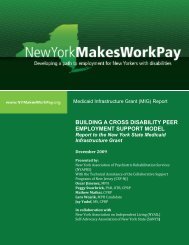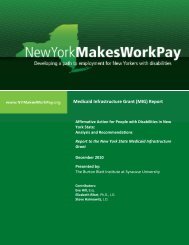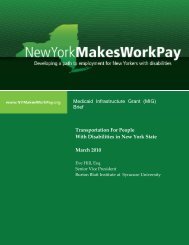Disability & Employment Law in New York State - Cornell University
Disability & Employment Law in New York State - Cornell University
Disability & Employment Law in New York State - Cornell University
Create successful ePaper yourself
Turn your PDF publications into a flip-book with our unique Google optimized e-Paper software.
<strong>Disability</strong> & <strong>Employment</strong> <strong>Law</strong> <strong>in</strong> <strong>New</strong> <strong>York</strong> <strong>State</strong>:Analysis and Recommendations7. Appeal: Decisions of the Division may be appealed <strong>in</strong> court. 100Some states and the ADA make the adm<strong>in</strong>istrative compla<strong>in</strong>t process a gate-keep<strong>in</strong>gfunction. Under the ADA, a legal claim cannot proceed <strong>in</strong> court until the Equal<strong>Employment</strong> Opportunity Commission (EEOC) issues a “right to sue letter” or until theagency has completed its <strong>in</strong>ternal processes, at which po<strong>in</strong>t a person can appeal thatdecision <strong>in</strong> court. 101 Workers <strong>in</strong> <strong>New</strong> <strong>York</strong>, however, have the benefit of access to eitherthe state courts or the Division of Human Rights. It is possible to bypass the Divisionentirely if a trial is preferred. The only limitation is that a person cannot pursue bothoptions simultaneously – it is not possible to go to trial, while also await<strong>in</strong>g a hear<strong>in</strong>g orenter<strong>in</strong>g conciliation through the Division of Human Rights. 102There are some reasons why pursu<strong>in</strong>g a compla<strong>in</strong>t through an adm<strong>in</strong>istrative processmay be preferable to a judicial fil<strong>in</strong>g. For <strong>in</strong>stance, it generally is easier to representoneself through adm<strong>in</strong>istrative compla<strong>in</strong>t processes than to proceed without an attorney<strong>in</strong> court. In addition, the agency bears the cost of <strong>in</strong>vestigation and hear<strong>in</strong>g, whereasgo<strong>in</strong>g to court <strong>in</strong>volves court costs and attorneys’ fees, which cannot be recovered fromthe los<strong>in</strong>g party <strong>in</strong> NYSHRL employment claims. 103On the other hand, fil<strong>in</strong>g a compla<strong>in</strong>t with the Division of Human Rights must beaccomplished with<strong>in</strong> one year, 104 whereas the statute of limitations to file anemployment discrim<strong>in</strong>ation claim <strong>in</strong> a state court is three years from the orig<strong>in</strong>at<strong>in</strong>g<strong>in</strong>cident. 105 In contrast, the EEOC requires that a compla<strong>in</strong>t first be filed with<strong>in</strong> 180 daysof the discrim<strong>in</strong>atory <strong>in</strong>cident, although that deadl<strong>in</strong>e can be extended to 300 dayswhere a claim is based on violations of both federal and state disability civil rightslaws. 106 Regardless, the NYSHRL allows for more time than that available for ADAclaims, both for Division compla<strong>in</strong>ts and lawsuits.Division <strong>in</strong>vestigators, prosecutors and hear<strong>in</strong>g officer staff receive <strong>in</strong>itial tra<strong>in</strong><strong>in</strong>g onrequirements for reasonable accommodation and <strong>in</strong>teractive process, and have options100 Id. § 298.101 ADA, 42 U.S.C. §§ 2000(e)(5)(c), 12117(a).102 N.Y. Exec. <strong>Law</strong> § 297(9). If an <strong>in</strong>dividual has filed a compla<strong>in</strong>t with the Division, and decides to go tocourt, (s)he may voluntarily dismiss the compla<strong>in</strong>t with the Division <strong>in</strong> order to move forward <strong>in</strong> the statecourt system.103 See id. § 297(9)-(10).104 Id. § 297(5).105See Edgar De Leon, Basic <strong>New</strong> <strong>York</strong> <strong>State</strong> <strong>Employment</strong> <strong>Law</strong>,http://www.deleonlawyers.com/CM/Articles/article-ny-employment-law.asp (last visited Feb. 19, 2010).Where discrim<strong>in</strong>atory actions are cont<strong>in</strong>u<strong>in</strong>g, courts have sometimes allowed related events that tookplace more than three years ago to be treated as “timely” under the NYSHRL. Gangemi <strong>Law</strong> Firm, P.C.,Primer on the <strong>New</strong> <strong>York</strong> <strong>State</strong> Human Rights <strong>Law</strong>,http://www.newyorkemploymentattorneyblog.com/2008/06/primer_on_the_new_york_state_h.html (lastvisited February 19, 2010).106 See Equal <strong>Employment</strong> Opportunity Commission, Federal <strong>Law</strong>s Prohibit<strong>in</strong>g Job Discrim<strong>in</strong>ationQuestions and Answers, http://www.eeoc.gov/facts/qanda.html (last visited March 24, 2010).16





